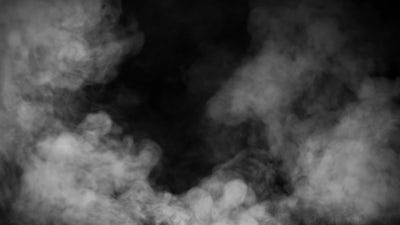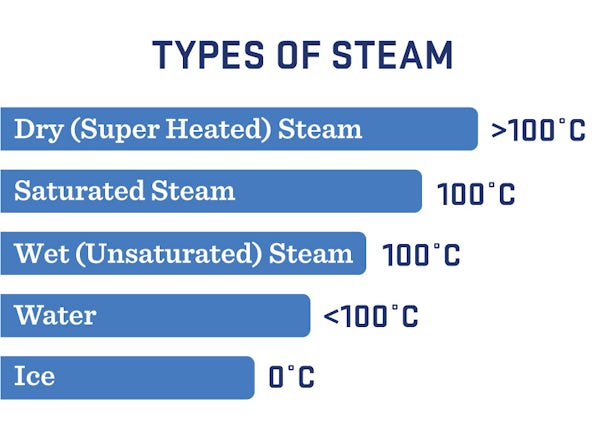The Different Types of Steam in Industrial Steam Generation
- Share on Facebook
- Share on LinkedIn
- Share on Email
-
Copy Link
-
Share Link
- Pharmaceutical
- July 22, 2021
- 2 Minute Read
- Share on Facebook
- Share on LinkedIn
- Share on Email
-
Copy Link
-
Share Link

Commercial Steam Generation
Commercial steam generation is a crucial function for many industries as an effective heating medium. For industrial processes, selecting the appropriate type of steam is dictated by the specific application and regulations for quality and sterilization. In the process of condensing from steam to water for industrial applications, steam gives up its heat of vaporization or latent heat. This is the amount of heat that it takes to transform a liquid into a gas at the same temperature. At atmospheric pressure and 212°F (100°C), it takes 970 BTU/LBM to transform water into steam. So, when steam condenses, it gives off that same heat. If you compare the heat that it takes to raise the temperature of water from its freezing point to its boiling point (sensible heat) to the heat that it takes just to turn it from a liquid to a vapor (latent heat), the latent heat is around five times more than the sensible heat. So, if you’ve got saturated steam being used as a heating source for your heat exchanger, it’s at the boiling point, ready to give off latent heat.
Many different terms describe steam – dry, wet, saturated, superheated, plant, utility, pure, and clean – but what does each mean?

Four Types of Steam Generation in Industrial Applications
Saturated Steam
Saturated steam is the most common, especially in pharmaceutical industry applications. Saturated steam is essentially steam at its boiling point. The most common example is steam at atmospheric pressure. At this pressure, saturated steam would be at 212°F (100°C). As the pressure of the steam increases, so does its corresponding boiling point temperature. This relationship can be seen in steam tables, which are charts of industrial steam temperature versus pressure for saturated steam.
Superheated Steam
Superheated steam is hotter than the boiling point for a given pressure. In the example above, it would be hotter than 212°F (100°C) but still at atmospheric pressure.
Dry Steam
Dry steam is entirely in the vapor state, and has no liquid in it. Superheated steam is always dry because any liquid is immediately heated into steam. Saturated steam can be essentially dry, or at least dry enough to do the job! To keep your saturated steam dry, it is necessary to trap it effectively so that any water is removed before the steam gets to its use point.
Wet Steam
Wet steam is simply the opposite of dry steam. It has both liquid and vapor present. The liquid takes up space in the flow, but does not contribute effectively to the heat transfer since it has already given up its heat of vaporization. Unsaturated steam can also be described as Wet Steam.

Steam Categories
The designations below tell you about the cleanliness of the steam, including any additives. These categories of designations help to fully describe the different types of steam and ensure they are correct for the application.
Plant Steam (Also Called Utility Steam)
Plant steam, or utility steam, is “typical” for industrial steam generation systems. It can be at a variety of pressures but is typically saturated. Plant steam usually has boiler chemicals or additives to prevent corrosion, so in many cases, it cannot be directly added to products. Utility steam is sometimes referred to by the pressure at which it’s distributed, which is either low, medium, or high-pressure steam. The exact pressure of each of these will vary at different locations and industries.
Clean Steam
Clean steam is pure enough that, when condensed, it meets the requirements for Water for Injection. A clean steam generator typically utilizes saturated steam and is often used in cleaning, sterilization, and heating applications in the pharmaceutical industry where direct product contact may occur.
In the pharmaceutical industry, many users of clean steam generators are bound by the requirements of European standard EN285. This standard addresses dryness, superheat, and noncondensable gasses present in steam used in autoclaves. Dryness and superheat are both addressed above; however, noncondensable gasses are issues unique to autoclaves. These gasses—typically nitrogen, oxygen, or carbon dioxide—take up space in the saturated steam without contributing to the available heat transfer. Excessive amounts of noncondensable gasses can prevent an autoclave from operating as it has been qualified.
More from Mueller Academy
- Introducing Our New Membrane-Based Water for Injection (WFI) Skids
- Manway Gasket Installation & Bushing Adjustment
- How to Decide Between a Horizontal & Vertical Milk Tank
- MES & PSG Feedwater Quality Requirements
- On-Site Tank Fabrication Under Deadline
- Finding the Right Finish: Understanding Polishing
- Increase the Capacity of Your Clean Utility Equipment
- Balancing a Mueller Multiple Effect Still (MES)
- How a Pure Steam Generator Works